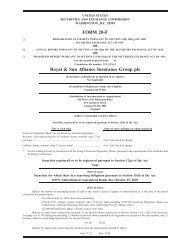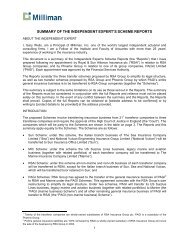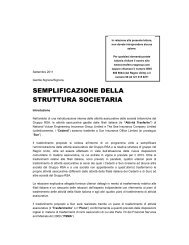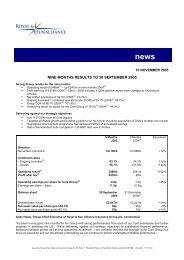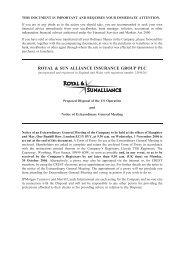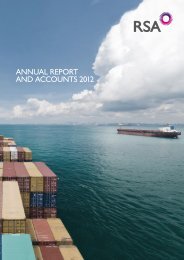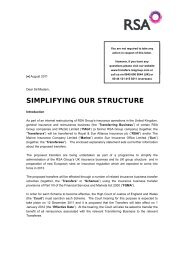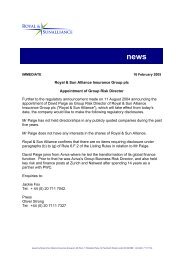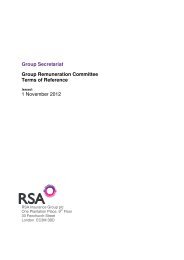PDF - Royal and Sun Alliance
PDF - Royal and Sun Alliance
PDF - Royal and Sun Alliance
You also want an ePaper? Increase the reach of your titles
YUMPU automatically turns print PDFs into web optimized ePapers that Google loves.
The pension assets <strong>and</strong> pension <strong>and</strong> post retirement liabilities are calculated in accordance with International Accounting<br />
St<strong>and</strong>ard 19 (IAS 19). The assets, liabilities <strong>and</strong> income statement charge, calculated in accordance with IAS 19, are<br />
sensitive to the assumptions made from time to time, including inflation, interest rate, investment return <strong>and</strong> mortality. IAS<br />
19 compares, at a given date, the current market value of a pension fund’s assets with its long term liabilities, which are<br />
calculated using a discount rate in line with yields on ‘AA’ rated bonds of suitable duration <strong>and</strong> currency. As such, the<br />
financial position of a pension fund on this basis is highly sensitive to changes in bond rates <strong>and</strong> will also be impacted by<br />
changes in equity markets.<br />
Uncertainties <strong>and</strong> contingencies<br />
The uncertainty arising under insurance contracts may be characterised under a number of specific headings, such as:<br />
• uncertainty as to whether an event has occurred which would give rise to a policyholder suffering an insured loss;<br />
• uncertainty as to the extent of policy coverage <strong>and</strong> limits applicable;<br />
• uncertainty as to the amount of insured loss suffered by a policyholder as a result of the event occurring; <strong>and</strong><br />
• uncertainty over the timing of a settlement to a policyholder for a loss suffered.<br />
The degree of uncertainty will vary by policy class according to the characteristics of the insured risks <strong>and</strong> the cost of a<br />
claim will be determined by the actual loss suffered by the policyholder.<br />
There may be significant reporting lags between the occurrence of the insured event <strong>and</strong> the time it is actually reported to<br />
the Group. Following the identification <strong>and</strong> notification of an insured loss, there may still be uncertainty as to the<br />
magnitude <strong>and</strong> timing of the settlement of the claim. There are many factors that will determine the level of uncertainty<br />
such as inflation, inconsistent judicial interpretations <strong>and</strong> court judgments that broaden policy coverage beyond the intent<br />
of the original insurance, legislative changes <strong>and</strong> claims h<strong>and</strong>ling procedures.<br />
The establishment of insurance liabilities is an inherently uncertain process <strong>and</strong>, as a consequence of this uncertainty, the<br />
eventual cost of settlement of outst<strong>and</strong>ing claims <strong>and</strong> unexpired risks can vary substantially from the initial estimates,<br />
particularly for the Group’s long tail lines of business. The Group seeks to provide appropriate levels of claims provision<br />
<strong>and</strong> provision for unexpired risks taking the known facts <strong>and</strong> experience into account.<br />
The Group has exposures to risks in each class of business within each operating segment that may develop <strong>and</strong> that<br />
could have a material impact upon the Group’s financial position. The geographic <strong>and</strong> insurance risk diversity within the<br />
Group’s portfolio of issued insurance policies make it not possible to predict whether material development will occur <strong>and</strong>,<br />
if it does occur, the location <strong>and</strong> the timing of such an occurrence. The estimation of insurance liabilities involves the use<br />
of judgments <strong>and</strong> assumptions that are specific to the insurance risks within each territory <strong>and</strong> the particular type of<br />
insurance risk covered. The diversity of the insurance risks results in it not being possible to identify individual judgments<br />
<strong>and</strong> assumptions that are more likely than others to have a material impact on the future development of the insurance<br />
liabilities.<br />
The sections below identify a number of specific risks relating to asbestos <strong>and</strong> environmental claims. There may be other<br />
classes of risk which could develop in the future <strong>and</strong> that could have a material impact on the Group’s financial position.<br />
The Group evaluates the concentration of exposures to individual <strong>and</strong> cumulative insurance risk <strong>and</strong> establishes its<br />
reinsurance policy to reduce such exposure to levels acceptable to the Group.<br />
Asbestos <strong>and</strong> environmental claims<br />
The estimation of the provisions for the ultimate cost of claims for asbestos <strong>and</strong> environmental pollution is subject to a<br />
range of uncertainties that is generally greater than those encountered for other classes of insurance business. As a<br />
result it is not possible to determine the future development of asbestos <strong>and</strong> environmental claims with the same degree<br />
of reliability as with other types of claims, particularly in periods when theories of law are in flux. Consequently, traditional<br />
techniques for estimating claims provisions cannot wholly be relied upon <strong>and</strong> the Group employs specialised techniques<br />
to determine provisions using the extensive knowledge of both internal asbestos <strong>and</strong> environmental pollution experts <strong>and</strong><br />
external legal <strong>and</strong> professional advisors.<br />
Factors contributing to this higher degree of uncertainty include:<br />
• the long delay in reporting claims from the date of exposure (for example, cases of mesothelioma can have a latent<br />
period of up to 40 years). This makes estimating the ultimate number of claims we will receive particularly difficult;<br />
• issues of allocation of responsibility among potentially responsible parties <strong>and</strong> insurers;<br />
• emerging court decisions <strong>and</strong> the possibility of retrospective legislative changes increasing or decreasing insurer<br />
liability;<br />
• the tendency for social trends <strong>and</strong> factors to influence court awards;<br />
• developments pertaining to the Group’s ability to recover reinsurance for claims of this nature; <strong>and</strong><br />
• for US liabilities from our London market business, developments in the tactics of US plaintiff lawyers <strong>and</strong> court<br />
decisions <strong>and</strong> awards.<br />
18 Ι RSA Ι 2008 Year End Results Ι 26 February 2009



